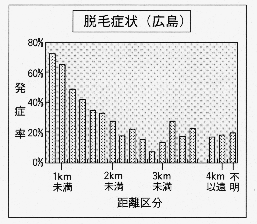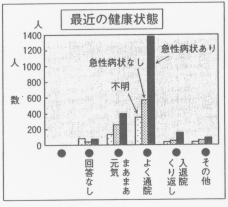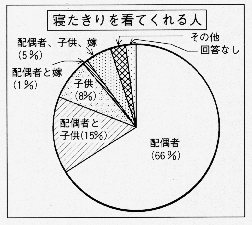About Hidankyo
Data
A Call from Hibakusha of Hiroshima and Nagasaki
From monthly paper "Hidankyo"-March 1997-
The analysis of the survey of the A-bomb sufferers in 1995
The survey committee of HIDANKYO nearly completes the analysis of "the survey of the A-bomb sufferers" conducted in 1995 for 4000 A-bomb victims as one of HIDANKYO's projects in memory of 50th anniversary of the A-bombings.
The number of the answerers amounted to 3592. By the location of the suffering,64% were in Hiroshima, and 36% in Nagasaki. Above all, two persons encountered A-bomb raids in both cities. By age bracket, peopled ranging from 65 years old to 69 are the highest number of the answerers.
Reviewing the situation of the suffering, those who entered in the city after the bombing, are 27% of total answerer suffered in Hiroshima, while 16% in Nagasaki. It is conceivable that there were more people in Hiroshima than in Nagasaki who became A-bomb sufferers because of entrance in the city after the bombing for the relief of victims.
Among those who had direct suffering at a distant location away from the hypocenter of bombing, higher percentage of such sufferers than our expectation, answered that they experienced certain acute symptoms after the bombing. Most of those sufferers entered in the heart of the city for the relief of victims or the search of their relatives.
As far as the radiation damage of the distant sufferers are concerned, it would be a mistake if we judged the radiation damage only by the distance between their suffering site and the hypocenter of bombing.
More importantly, 5 to 10% of such distant sufferers answered that they suffered from the symptom of falling off of hair(alopecia).(c.f. graph)
Regarding the recent health conditions of sufferers, 64% answered that they frequently attend to hospitals. In relation to acute symptoms after the bombing,60% of those who answered to go to hospitals frequently and 70% of those who answered to repeat hospitalization, experienced acute symptoms. About 80% of 17persons who were on relief also suffered from acute symptoms.
As for the present family make-up, living with a couple shows high percentage. 47.7% of all answerers live alone with a spouse, although there is a slight difference between big cities and small towns/agricultural or fishing villages. Among this group of answerers, 66.4% of those who answered there are someone to look after in case of being laid up with illness, mention their spouse as a person to take care of them.
Is it possible for the couple of advanced age to nurse their aged bedridden partner? This is not only limited to the A-bomb sufferers, but nursing the aged people in Japan seems to become clear in the limelight.
Not a small number of the sufferers answered that there is no one to take care of them nor to counsel to them. The results of this survey in 1995 clearly show that reticulated support system should be further strengthened for solving problems that those A-bomb sufferers who lost their children on the A-bombing or hesitated to get married are now confronting, with advanced ages.
First official report on the survey will be presented by the time of the annual meeting of HIDANKYO scheduled in June.
![]()
<Reference>
 Graph1
Graph1  Graph2
Graph2
Graph 1: and 2:
Occurrence of Alopecia (falling off ot hairs) in Hiroshima(Graph 1), and Nagasaki(Graph 2)
Axis; horizontal Distance less than 1km, ......, farther than 4km, Unknown
Axis; vertical Ratio of occurrence %
 Graph3
Graph3
Graph 3:
Recent health conditions
Axis; horizontal No answer, Fairly good, Frequent attendance to hospitals, Repeated
hospitalization
Axis; vertical Number of persons

Pie chart
Who will take cere of sufferers in case of being confined to bed with illness?
Spouse (66%), Spouse and children (15%), Children (8%), Spouse and daughters in law (1%),
Spouse, children and daughters in law (5%), Others, No answer
![]()
